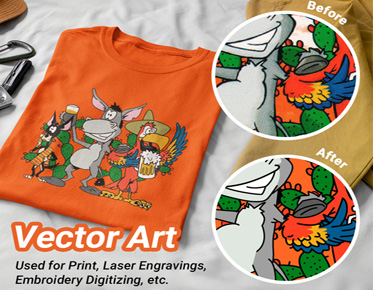Is the USA Stitching Its Future with Digital Embroidery?
The
Rise of Digital Embroidery in the USA
The landscape of
embroidery in the USA is undergoing a transformation, driven by technology’s
relentless march forward. What was once a hand-crafted tradition rooted in
artistry is now increasingly taking shape through digital innovation. Digital embroidery, once a niche pursuit, is now
revolutionizing industries from fashion to corporate branding. This change
represents not only a shift in how embroidery is made but also a broader trend
of technology blending with traditional crafts.
Why
the Craft of Embroidery is Going Digital
Embroidery has
always been a labor-intensive craft, rich with heritage and artistry. Yet, in
today’s fast-paced world, the demand for faster production, higher precision,
and the ability to scale is pushing the craft towards digitization. The
traditional methods, while revered, are simply not suited for the mass
production needs of modern businesses. Enter digital embroidery: a technology
that brings efficiency to the art of stitching without sacrificing detail.
The craft’s
digital evolution allows for faster turnaround times and the ability to
replicate intricate designs with ease. What once required hours of meticulous
hand stitching can now be accomplished in a fraction of the time. This wave of
efficiency appeals to a variety of industries, including fashion, marketing,
and small businesses that need to deliver high-quality, customized products
quickly.
The
Intersection of Tradition and Technology in Crafting
At its core,
embroidery is about expression—an art form that has been passed down through
generations. The digitalization of this craft raises an intriguing question:
Can the soul of embroidery remain intact while embracing technology? As
machines take over the tedious aspects of stitching, artists and designers are
now free to focus more on creativity and design rather than the mechanics of
the process.
By blending the
warmth of traditional techniques with the precision of modern technology,
digital embroidery offers an exciting hybrid that keeps the spirit of the craft
alive. It’s not about replacing the artist’s touch, but rather about enhancing
it, offering new possibilities that were previously unimaginable.
A
Glimpse into the Future: Will Digital Embroidery Dominate?
Looking ahead,
digital embroidery holds the potential to dominate the future of textile arts.
The combination of speed, precision, and cost-effectiveness makes it a
compelling choice for industries that require large-scale production, like
fashion and promotional products. Additionally, the ability to reproduce
designs flawlessly opens up a world of possibilities for mass customization—an
industry trend that continues to gain traction. As machines become smarter and
software more intuitive, we can expect digital embroidery to become more
accessible, pushing even more artists and businesses into the fold.
But what does
this mean for the future of hand embroidery? Traditional methods won’t
disappear overnight, but digital embroidery might very well become the norm.
It’s not about choosing one over the other—it’s about embracing both to create
a vibrant, multifaceted embroidery landscape.
Understanding Digital Embroidery: What’s the Buzz?
What is Digital Embroidery?
Digital
embroidery refers to the process of creating embroiderydesigns using specialized computer software, which are then transferred
to a machine that stitches out the design. This method allows for greater
precision, efficiency, and the ability to replicate designs consistently
without manual intervention. It’s a seamless fusion of art and technology,
where digital tools bring the designer’s vision to life through automated stitching.
Unlike
hand-stitched embroidery, where each stitch is made manually, digital
embroidery uses a digitized file to control the stitching pattern, ensuring
perfect alignment, color matching, and design accuracy every time.
How Does Digital Embroidery
Work?
The process
starts with a digital design file, which is created using embroidery software
like Adobe Illustrator or specialized embroidery programs. These designs are
then converted into a format that can be read by embroidery machines. The
machine uses this information to stitch the design onto fabric, thread by
thread, automatically adjusting for factors like tension and stitch length.
The beauty of
digital embroidery lies in its ability to produce complex, multi-colored
designs at a rapid pace, ensuring uniformity across each product or piece. With
the click of a button, what once took hours can now be completed in a matter of
minutes.
The Tools Behind Digital Embroidery: Machines, Software, and Techniques
The backbone of
digital embroidery is its tools: the embroidery machine,
specialized software, and the digitizing technique that transforms artwork into
stitch patterns. Machines like the Brother PE800 or Bernina 880 Plus are
equipped with advanced features that allow for automatic thread changes,
multi-needle capability, and intricate stitching patterns.
On the software
side, programs like Wilcom, Hatch, and CorelDRAW help designers create the
perfect design file. These tools allow for seamless integration between design
and execution, providing designers with the control they need to customize
every aspect of the final piece.
The
Evolution of Embroidery: From Hand-Stitched to Machine-Stitched
A Brief History of Embroidery in
the USA
Embroidery has a
long history in the United States, stretching back to Native American tribes
who used the craft for decorative purposes. By the 19th century, embroidery had
evolved into an intricate art form, with both decorative and functional uses in
textiles. As industrialization took hold, there was a shift towards machine
embroidery, but it wasn’t until the late 20th century that digital technology
truly began to impact the craft.
The Shift from Handmade to
Machine-Made: A Craft Revolution
The 20th century
brought with it a shift in how embroidery was produced, as machines began to
take over the process. The early machines simply automated basic stitches, but
the introduction of digital technology in the 1980s took things to a whole new
level. Today, machines can produce intricate, detailed designs with speed and precision
that would have been impossible by hand. While many artisans still hold the
traditional hand-stitched methods dear, machine embroidery has become the go-to
choice for mass production and large-scale operations.
How the USA Has Embraced the
Craft Over Time
The USA has been
at the forefront of adopting and advancing digital embroidery techniques. From
the rise of custom apparel companies to the explosive growth of small
businesses offering personalized goods, American entrepreneurs have been quick
to embrace the potential of digital embroidery. The accessibility of technology
has allowed anyone with a creative vision to enter the industry, offering a
democratization of craftsmanship.
The Role of Technology in Embroidery’s Transformation
From Thread to Pixels: How Tech
is Shaping the Industry
Technology has
reshaped every aspect of the embroidery process, from the design stage to the
final product. Today, designers can use digital tools to create complex,
multi-layered designs that would have been unthinkable just a few decades ago.
The integration of software and machines means that the creative possibilities
are virtually limitless, allowing designers to push the boundaries of what’s
possible with thread and fabric.
Software Innovations: Making
Designs More Accessible
Software
advancements have made it easier than ever for designers to bring their visions
to life. With intuitive interfaces and powerful capabilities, today’s embroidery software can handle everything from simple
logos to intricate patterns. These innovations have opened up digital
embroidery to a wider audience, enabling artists and entrepreneurs to create
and produce designs with ease.
The Importance of Automation in the Craft Industry
Automation is
crucial in the modern embroidery landscape. Machines that can work round the
clock, without fatigue or error, are invaluable to businesses that need to
produce large quantities of high-quality, customized products. Automation also
allows for faster turnaround times, meeting the demands of industries like
fashion and promotional products, where speed and consistency are key.
Is
Digital Embroidery the Future of Crafting in the USA?
Breaking Traditional Barriers:
Digital Embroidery vs. Handcrafting
While
handcrafting has a timeless quality, digital embroidery offers a speed and
precision that’s hard to ignore. But does this mean the death of hand-stitched
embroidery? Not necessarily. Rather than replacing traditional methods, digital
embroidery enhances them, offering artisans the ability to reach new audiences
and explore innovative techniques. The challenge lies in striking a balance
between maintaining the authenticity of handcrafting while embracing the
benefits of technology.
Can Machines Truly Replace Human
Creativity?
Machines may be
able to replicate designs with incredible precision, but they lack the
emotional depth and creativity of a human artist. While digital embroidery
allows for flawless execution, it’s the human touch that gives designs their
soul. The real value of digital embroidery lies in how it can augment human
creativity, allowing artists to focus on their vision while leaving the
technical aspects to the machine.
How Digital Embroidery is
Revolutionizing the Fashion Industry
Digital
embroidery is increasingly finding its place in the world of fashion, with
designers using it to create intricate, eye-catching patterns on garments. The
ability to produce detailed embroidery at a fast pace allows fashion houses to
introduce new collections quickly, meeting the fast-paced demands of the
industry. Furthermore, the precision of digital embroidery enables designers to
experiment with new styles and materials, pushing the boundaries of what’s
possible in fashion design.
The Advantages of Going Digital: Why the USA is Turning to Machines
Efficiency and Speed: The Modern Embroidery
Advantage
One of the most significant advantages of
digital embroidery is its speed. What once took hours or even days to complete
can now be done in a fraction of the time. Machines can work tirelessly,
ensuring that designs are produced quickly and accurately, which is vital in
industries like fashion, advertising, and merchandising. The ability to meet
tight deadlines and produce large quantities of customized goods is a
game-changer for many businesses. With digital embroidery, companies can also
maintain a quick turnaround for large orders, improving their overall
responsiveness to market demands. This enhanced efficiency allows businesses to
scale their operations and meet customer expectations with ease.
Precision and Consistency: Perfect Stitches Every
Time
The precision of digital embroidery is
unparalleled. With every design perfectly executed, digital machines eliminate
the variability that comes with manual stitching. This level of consistency
ensures that each piece of embroidery is identical, making digital embroidery
ideal for projects that require uniformity, such as corporate branding or
large-scale apparel production. Additionally, digital embroidery machines can
handle intricate designs with remarkable accuracy, ensuring that even the
finest details are captured. As a result, businesses can maintain a high
standard of quality across all their products, leading to greater customer satisfaction
and fewer errors in the final output.
Cost-Effectiveness: How Businesses Are Benefiting
Although the initial investment in
digital embroidery equipment can be substantial, the long-term cost savings are
significant. Businesses save on labor costs, reduce waste, and increase output,
ultimately improving their bottom line. The ability to produce high-quality
embroidered goods at a fraction of the time and cost makes digital embroidery
an attractive option for both small businesses and large corporations. As
businesses can produce more designs with fewer resources, they can also pass on
savings to customers, remaining competitive in the market. The technology also
reduces material waste by using precise cutting and stitching techniques,
further enhancing its cost-effectiveness.
Customization: The New Era of Personalization in
Embroidery
With digital embroidery, customization is
king. Consumers now expect personalized products, and digitalembroidery makes it easier than ever to deliver exactly what they want.
From custom clothing to branded merchandise, digital embroidery offers
businesses the ability to offer one-of-a-kind designs tailored to individual
preferences, opening up new revenue streams and increasing customer loyalty.
This ability to create unique, customized items not only meets consumer demands
but also allows businesses to differentiate themselves in a crowded
marketplace. As personalization becomes increasingly important, digital
embroidery gives businesses a powerful tool to create distinctive products that
resonate with customers.
.png)


